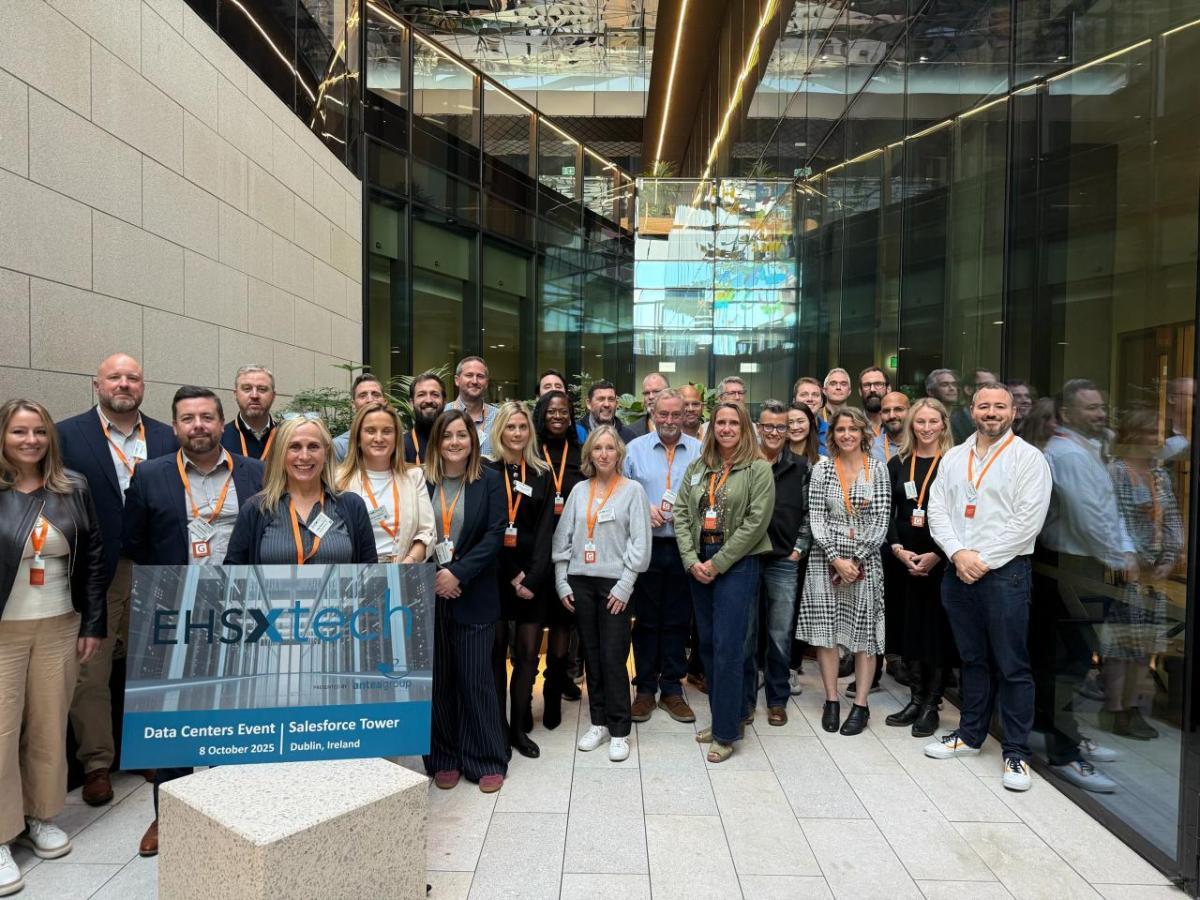
2025 Data Center Ehsxtech® Insights: Power, Safety By Design, AI, And Hras
From AI in EHS, safety by design, training and metrics, and predictive modeling to supplier quality and grid resilience, the message was clear: technology is advancing fast-but human oversight and collaboration remain essential, especially with the rapid growth and expansion of the data center industry.
Below are the top takeaways from this event and actions EHS leaders can apply to data centers today.
1. AI and EHS: From Experiment to Everyday Use
AI has moved beyond the experimental phase to become a tool used daily to improve data quality, support real time monitoring, and optimize daily workflows. Many organizations are using AI tools like Copilot, Gemini, ChatGPT, and PagerDuty to manage alarms, summarize incidents, and streamline documentation.
One company at the event even created an AI assistant that instantly answers internal safety policy questions, saving hours of research. Others reported using AI for:
-
Comparing old and new safety procedures against ISO standards
Creating incident summaries and action lists
Drafting training materials and toolbox talks
Reviewing Risk Assessment Method Statements (RAMS) for gaps
Using AI scoring to improve the quality of safety observations
But for all of these use cases, governance matters. Organizations are formalizing AI usage policies, privacy guardrails, data-retention rules, and human oversight protocols. Attendees' AI adoption was by no means uniform, but everyone recognized the importance of incorporating the technology into EHS processes and its potential to raise the bar in the EHS function.
2. Predictive Modeling and Ergonomics: Smarter Prevention
AI is helping predict risky patterns before incidents happen, especially in high-traffic zones and maintenance areas.
Some real-world examples included:
-
Thermal imaging for battery storage areas and electrical safety
Ergonomics assessments for office and remote workers
Continuous monitoring of posture and task strain through cameras and sensors
These innovations are helping companies shift from reactive safety to predictive prevention. Participants stressed the importance of piloting small projects, verifying results, and communicating clearly about data privacy and worker consent.
3. Safety by Design: Building Safety into Every Stage
Designed safety was a recurring theme, emphasizing that forethought and planning for safety need to happen during concept and design phases, not post-construction.
Shared best practices included:
-
Having a Safety by Design specialist at 30/60/90% design reviews
Including technician and vendor feedback in design decisions
Designing for access, ergonomics, and fall protection
Using sensors and load monitoring tools for preventative maintenance
Early incorporation of local regulations, such as worker welfare space requirements
To truly build safety into facilities and processes, design reviews need to go beyond procedure, with purposeful, human-centered attention to detail. Getting input from operations teams is a critical part of eliminating potential hazards before they become problems.
Dive deeper into this topic with our blog “Safety in Design: The First Step in Controlling Workplace Risks”
4. Quality and Supply Chain: Treating Quality as a Safety Issue
Several discussions brought up equipment and supplier quality challenges like untested cables, transformer failures, and material contamination. Each example led to costly delays, and, in some instances, safety risks.
Solutions that stood out included:
-
Conducting Factory Acceptance Tests (FATs) before delivery
Using owner-side inspectors to visit supplier facilities
Sharing quality alerts and recalls across teams
Holding monthly global incident calls to discuss lessons learned
One idea gaining traction was a shared“Quality Alerts Hub” for cross-industry visibility on equipment recalls and supplier risks.
5. Measuring What Matters: Smarter Safety Metrics
Participants discussed the limitations of traditional metrics, like recordable incident rates, and talked about better ways to measure effectiveness.
Emerging metrics included:
-
Percent of high-risk work with verified critical controls in place
Time to close corrective actions
AI-filtered observations that prioritize significant findings
Combining safety and operational metrics (rework, uptime, schedule) for a holistic view
The goal: focus on preventing incidents-not just counting them. Align definitions (like how hours are calculated) and share metrics regularly with leadership and frontline teams so comparisons stay meaningful.
The conversation will continue in coming months, as the Data Center Safety Council publishes calls to action on TRIR limitations within the data center industry.
6. Managing High-Risk Activities
Organizations are aligning on a common HRA list, consistent critical controls, and testing ways to embed HRA checks in both change management and job safety analysis, not just capital projects.
Nuances added this year:
-
Clarifying standard vs. non-standard work scenarios
Establishing common terms (e.g.,“critical controls” vs.“success factors”) to improve clarity
Real-world examples: critical lifts, live-energy electrical work, vehicle movements, confined spaces
The goal is to establish an effective leading indicator that shows whether the riskiest work is actually controlled, in real conditions.
7. Training That Scales: Digital Inductions and a Global Baseline
Teams are rolling out digital site inductions, which are short, multilingual video modules with safety culture questions, to save time and standardize onboarding. AI is helping summarize standards into short clips and translate content for global reach.
In parallel, the Data Center Safety Council is advancing a four-hour, self-paced Data Center Safety Awareness Certification to create a consistent baseline for operators and contractors worldwide.
8. Energy and Power: Safety in a Changing Grid
As data center growth accelerates, energy demand and grid capacity have become major safety and sustainability challenges.
Discussions explored:
-
Onsite generation models, including utility-leased/operated plants
Natural gas as a transitional bridge while capacity catches up
Battery Energy Storage System (BESS) siting concerns (e.g., electric and magnetic fields (EMF) and community acceptance)
The benefits of closed-loop cooling to reduce water and environmental risks
Longer-term options like small modular reactors (SMRs) and carbon capture, with strong community engagement
EHS and sustainability professionals were encouraged to take an active role in:
-
Assessing community and environmental risks
Supporting emergency response planning for new energy systems
Collaborating with utilities and regulators early in the planning process
9. Operating Across Jurisdictions: Same Outcomes, Local Paths
Participants compared U.K. and Ireland (stricter enforcement and conservation expectations) with U.S. practices and shared APAC experiences.
The takeaway was that it's crucial to agree on outcomes and critical controls first, then localize for legal, cultural, and enforcement realities.
Need multi-region support? Check out Inogen Alliance to get support wherever you are in the world.
10. Collaboration Is the Competitive Edge
Across topics, the winning behaviors were the same: sharing data, aligning definitions, publishing what works, and keeping people in the loop so professional judgment stays sharp.
Key actions for the year ahead:
-
Pilot AI tools for ergonomics, predictive safety, and incident summaries
Add Safety by Design representation in every major project review
Launch a global quality-alerts system
Refine safety awareness certification programs
Looking Ahead
The future of EHS isn't just digital; it's human-led, data-informed, and globally connected.
AI and automation are transforming the world of EHS, but true progress depends on design foresight, supplier collaboration, and a culture that values prevention over paperwork.
Interested in attending our next event? Connect with us to learn more.

Legal Disclaimer:
MENAFN provides the
information “as is” without warranty of any kind. We do not accept
any responsibility or liability for the accuracy, content, images,
videos, licenses, completeness, legality, or reliability of the information
contained in this article. If you have any complaints or copyright
issues related to this article, kindly contact the provider above.
Most popular stories
Market Research

- Currency Relaunches Under New Leadership, Highlights 2025 Achievements
- SPAYZ.Io White Paper Explores Opportunities, Challenges And Ambitions In Payments Industry
- Alt.Town Introduces $TOWN Token Utility Across Platform Services And Launches Valuefi Deposit Event
- Grok AI Identifies MGC And The RZ Ecosystem As A Safe Haven For Crypto Investors Amid Global Market Crash
- Salvium Solves The Privacy Paradox: Salvium One Delivers Mica-Compliant Privacy That Exchanges Can List
- Luminadata Unveils GAAP & SOX-Trained AI Agents Achieving 99.8% Reconciliation Accuracy




















Comments
No comment